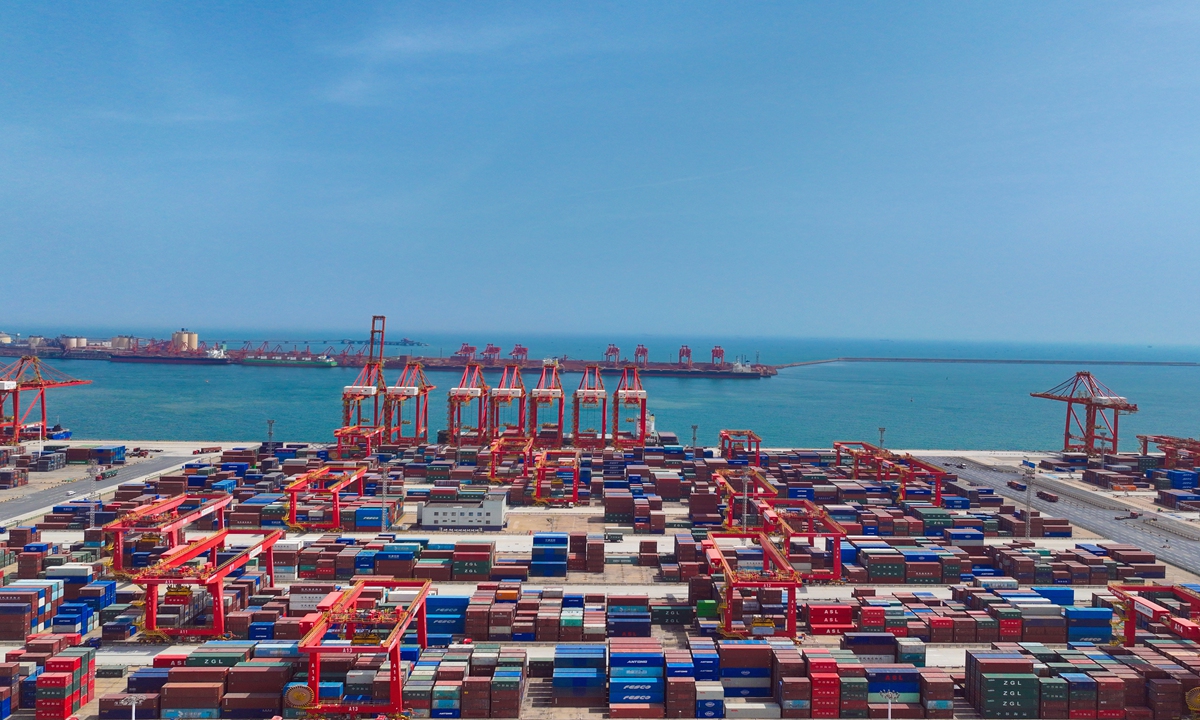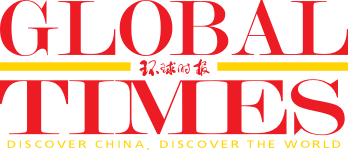
A view of Rizhao Port in Rizhao, East China's Shandong Province on April 8, 2025 Photo: VCG
In the context of an increasingly complex global trade landscape, the US has once again wielded the stick of tariffs, attempting to reinventing its economic strengths through the adoption of trade protectionism. However, the lessons of history should never be forgotten. In 1930, the US enacted the Smoot-Hawley Tariff Act, prompting other countries to raise their tariffs as well and triggering a global trade war. This move led to a sharp decline in international trade, exacerbating the duration and severity of the economic crisis that began in 1929. The lessons learned from this crisis profoundly influenced the formulation of subsequent trade policies.
The Smoot-Hawley Tariff Act is often regarded as a classic case of failure caused by protectionism. The warning from a century of trade protectionism is that, in the name of protecting the domestic economy, the US may overlook the effects of international chain reactions, potentially incurring costs far greater than anticipated.
With the aim to protect American agriculture and industry from foreign competition, the act raised tariffs on more than 20,000 imported items and increased the average tariff rate on dutiable imports to nearly 60 percent. Its original target was to alleviate the unemployment pressure at the early stages of the Great Depression and to boost farmers' incomes caused by the sharp drop in grain prices. However, results ran contrary to expectations.
From an industrial perspective, after the implementation of the act, US imports decreased by 28.4 percent within a year. The disruption of global trade chains obstructed the supply of domestic industrial raw materials and intermediate products in the US, raising manufacturing costs. The automotive industry was hit hard due to its heavy reliance on imported steel and parts, leading to a significant decline in capacity utilization.
From an agricultural perspective, US exports plunged by 66 percent between 1930 and 1932, with agricultural exports suffering the most. The decline in agricultural prices led to an increase in rural bank failures, which further reduced the money supply and exacerbated the economic recession.
From the international response perspective, Canada and Europe imposed retaliatory tariffs against the US, leading to a sharp decline in trade volume between the US and Europe. Global trade volume shrank by 66 percent, resulting in a worsening of domestic overcapacity in the US, with the unemployment rate soaring to 25 percent in 1933 from 3 percent in 1929.
From a historical context, the current "reciprocal tariffs" and the Smoot-Hawley Tariff Act were both implemented during times when the US faced economic pressure and challenges, aiming to protect domestic industries and employment. They have clear protectionist motives with the attempt to reduce import competition in the name of safeguarding national interests.
The Smoot-Hawley Tariff Act emerged during the early years of the Great Depression. In response to the economic collapse, the US Republican Party led the passage of the bill, attempting to save agriculture and industry through high tariffs. The drafting process of the bill was heavily influenced by lobbying from interest groups. Initially, the "agricultural lobby group," led by lawmakers from agricultural states, only sought to raise tariffs on agricultural products. However, the industrial sector seized the opportunity to demand an expansion of the protective scope, ultimately evolving into a comprehensive high tariff covering more than 20,000 goods. The "political distribution of benefits" caused the tax rates to diverge from actual economic needs, making the act a decision clearly characterized by populism.
Today, the US is facing the challenge of a disconnect between economic performance and public perception. High inflation has outpaced wage growth, shrinking real disposable income and actual purchasing power, making it difficult for workers and those in lower and middle-income brackets to make ends meet. The dissatisfaction among the American public with high inflation and the surge in immigration has led to a rise in populist sentiments, encouraging support for aggressive trade protectionism to correct the "trade imbalance" and bring jobs back to the US.
From US President Donald Trump's perspective, he has always praised a popular saying in the US that tariffs once contributed to the glory of American manufacturing in the 20th century. He believes that tariffs will enhance the overall output of US manufacturing, not only protecting future industries until they mature but also safeguarding the profit margins of already strong industries. "Reciprocal tariffs" reflect Washington's attempt to protect domestic jobs and industries amid rising populism at home.
Across US industries, the act had significant and varying effects across different sectors. In the light industry and agriculture sectors, tariff protection reduced import competition and stimulated domestic production. However, this protectionism has led to increased production costs, which in turn affected the competitiveness of other industries. Specifically, while the agricultural sector in the US benefited from the reduction in imported agricultural products, the industrial sector faced higher raw material costs, ultimately impacting overall economic growth.
The US' current "reciprocal tariffs" differ from the unilateral and comprehensive protections of the Smoot-Hawley Tariff Act, which was not explicitly targeted at specific countries and apply more flexibly across imports. "Reciprocal tariffs" aim to address trade deficits, intellectual property disputes and industrial policies related to specific countries, making them relatively more flexible. Currently, the US has set a 10 percent baseline tariff for its trading partners and imposes higher tariffs on certain partners, with a calculation method that is neither equitable nor fair.
A key warning from the Smoot-Hawley Tariff Act lies in the fact that short-term industry protection cannot outweigh the long-term costs of global supply chain disruptions and retaliatory measures from trade partners. Internationally, the act led to the collapse of multilateral trade system. Countries competed to build barriers, lacking a coordination mechanism, which resulted in the paralysis of the global trade system. The US' "reciprocal tariffs" will definitely disrupt the international capital markets and exacerbate the instability of the global trade system. The EU stated that if negotiations with the US yield no results, it may retaliate by imposing additional tariffs, utilizing anti-coercion tools and strengthening regulations on American tech giants. Canada's 25 percent tariff on US automobiles came into force at 12:01 am EDT on Wednesday.
The practical significance of the Smoot-Hawley Tariff Act lies in the fact that countries have come to recognize that unilateral protectionism often harms both the initiator and the target. International cooperation remains a superior path for resolving trade disputes. In the face of the US' "reciprocal tariffs," other countries may seek to mitigate unilateral pressure from the US by strengthening cooperation with other economies rather than the US. These countries may be committed to reaching more regional free trade agreements in order to hedge against the uncertainties of US trade policies and to diversify their trade relationships.
The author is an associate fellow at the Institute of American Studies, China Institutes of Contemporary International Relations. bizopinion@globaltimes.com.cn




